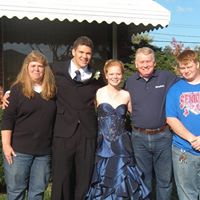Ronald Ross Vaughan
age ~79
from Placerville, CA
- Also known as:
-
- Ronald R Vaughan
- Ronald K Vaughan
- Ronald R Vaugn
- Ronald Vaughn
Ronald Vaughan Phones & Addresses
- Placerville, CA
- Lk Arrowhead, CA
- Odessa, MO
- Colton, CA
- Phoenix, AZ
- Ontario, CA
- 2590 Bryce Ct, Colton, CA 92324
Work
-
Position:Administrative Support Occupations, Including Clerical Occupations
Education
-
Degree:High school graduate or higher
Us Patents
-
Alkylation Process And Apparatus Useful Therein
view source -
US Patent:43179495, Mar 2, 1982
-
Filed:Feb 23, 1976
-
Appl. No.:5/660634
-
Inventors:Ronald J. Vaughan - Claremont CA
-
Assignee:Varen Technology - Marshallton DE
-
International Classification:C07C 266
C07C 270 -
US Classification:585458
-
Abstract:This invention relates to conversion processes which take place in the presence of solid acid catalysts, e. g. , hydrocarbon conversion processes. More specifically, this invention relates to a process for the alkylation of organic compounds, preferably aromatic and paraffinic hydrocarbons, with alkylating agents, e. g. , alkyl chlorides, alkyl sulfonates, alkyl epoxides, alkynes, etc. , in the presence of a polyfluorosulfonic acid catalyst. In one preferred embodiment of the instant process the selectivity to the monoalkylated reaction product of said organic compound and said alkylating agent is maximized by (1) refluxing a mixture comprising said compound and the alkylated derivative thereof, (2) separating from the mixture of step (1) an overhead product comprising said organic compound, said overhead product being substantially free from said alkylated derivatives, (3) condensing said overhead product, (4) contacting said condensed overhead product with said alkylating agent in the presence of a polyfluorosulfonic acid catalyst, at conditions whereby a portion of said organic compound is reacted to form the alkylated derivative thereof, and (5) returning the resultant mixture of the organic compound and its alkylated derivative to the refluxing mixture of step (1). Fresh organic compound may be continuously added to said refluxing mixture while continuously withdrawing said alkylated derivatives. Preferably said organic compound is benzene and said olefin is selected from the group consisting of ethylene and propylene.
-
Nitration Process
view source -
US Patent:39767043, Aug 24, 1976
-
Filed:Jan 6, 1975
-
Appl. No.:5/538723
-
Inventors:Ronald J. Vaughan - Claremont CA
-
Assignee:Varen Technology - Marshallton DE
-
International Classification:C07C 7910
-
US Classification:260645
-
Abstract:This invention relates to a process for the nitration of organic compounds, especially aromatic compounds, which comprises contacting said compound with a nitrating agent at conditions whereby a nitrated product is formed. The nitration agent and the compound are substantially separated by means of a polymeric membrane, said polymeric membrane preferably comprising sulfonic acid groups, pendant to the polymeric backbone. In a most preferred embodiment, the membrane is a perfluorosulfonic acid polymer. The use of this most preferred polymeric material as a membrane in the instant process allows the nitration of aromatic organic compounds to take place without the incorporation of strong sulfuric acid in the nitrating agent.
-
Self-Activated No-Back Device
view source -
US Patent:20230115546, Apr 13, 2023
-
Filed:Oct 8, 2021
-
Appl. No.:17/497396
-
Inventors:- Charlotte NC, US
Jiri Berjak - Brno, CZ
Ronald Vaughan - Tempe AZ, US
Tomas Ripel - Brno, CZ -
Assignee:HONEYWELL INTERNATIONAL INC. - Charlotte NC
-
International Classification:F16D 59/02
F16D 65/02
F16D 55/38
F16D 55/04 -
Abstract:A self-activated no-back device includes a housing, an input shaft, an output shaft, a reactor hub, first grooves, a brake hub, second grooves, a plurality of balls, a reactor plate, a brake pack, a reactor spring, and a load spring. The first grooves are formed on an interior side of the reactor hub interior side, and the second grooves are formed in an interior side of the brake hub. Each second groove is aligned with a different first groove to define a plurality of groove pairs. Each ball is positioned in a different one of the groove pairs. One side of the reactor plate contacts the reactor hub. The brake pack is selectively contacted by the brake hub. The reactor spring supplies a spring force to the reactor plate, and the load spring supplies a spring force to the brake pack.
Resumes

Ronald Vaughan
view source
Ronald Joseph Vaughan
view source
Ronald Vaughan
view sourceLocation:
United States
Name / Title
Company / Classification
Phones & Addresses
President
K W INSTRUMENTS, INC
Whol Industrial Equipment
Whol Industrial Equipment
PO Box 1181, Lk Arrowhead, CA 92352
PO Box 1131, Lk Arrowhead, CA 92352
1012 E Cooley Dr, Colton, CA 92324
(909)5142500
PO Box 1131, Lk Arrowhead, CA 92352
1012 E Cooley Dr, Colton, CA 92324
(909)5142500
Myspace

Ronald Vaughan
view sourceFlickr

Ronald Vaughan
view source
Ronald Vaughan
view source
Ronald Vaughan
view source
Ronald Vaughan
view source
Ronald Vaughan
view source
Ronald Smokeone Vaughan
view source
Ronald Vaughan
view source
Ronald Vaughan
view sourcePlaxo

Ronald Vaughan, PMP, CMIIC
view sourceStuttgart, GErmanyNetwork Design Engineer at SAIC
Classmates

Ronald Vaughan
view sourceSchools:
West High School West Bend WI 1986-1990
Community:
Chris Hagedorn

Ronald Vaughan
view sourceSchools:
Tantasqua Regional High School Fiskdale MA 1978-1982
Community:
Linda Langlois

Ronald Vaughan
view sourceSchools:
Warwick High School Newport News VA 1957-1961
Community:
Collin Long, Ronald Fox

Ronald Vaughan
view sourceSchools:
American International High School Vienna Austria 1964-1968
Community:
David Formanek, Toni Gallant, Alex Spinrad, Anna Gruber, Tanya Jeyachandran

Ronald Vaughan
view sourceSchools:
Charlotte B. Allen Elementary School Houston TX 1956-1962, Hamilton Junior High School Houston TX 1962-1965
Community:
Sandi Brooks, Gina Harrison, Drew Lozinski

Ronald Vaughan
view sourceSchools:
Murfreesboro High School Murfreesboro NC 1980-1984
Community:
Barbara Higginbotham, Brent Harmon, Irene Fennell, Kim Smith, Greg Felton, Garrat Shelton, Gilbert Everett, Monique Parker, Tracy Greene, Brenda Artis, Susie Warren

Ronald Vaughan | Moss Poi...
view source
Ronald Vaughan | Rogersvi...
view sourceGoogleplus

Ronald Vaughan
Education:
West Bend West

Ronald Vaughan

Ronald Vaughan

Ronald Vaughan

Ronald Vaughan

Ronald Vaughan

Ronald Vaughan
Youtube
Get Report for Ronald Ross Vaughan from Placerville, CA, age ~79
















